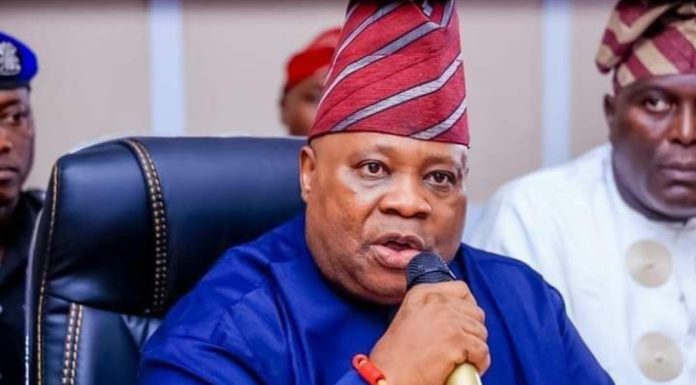Governor Ademola Adeleke on Wednesday presented a total of 390,028,277,740.00 as the 2025 Appropriation Bill of his administration before the State House of Assembly in Osogbo, targeting major investments in healthcare, education, and infrastructure, while pledging not to rely on loans to fund the state’s ambitions.
Presenting the budget, Adeleke framed it as a plan to accelerate development responsibly.
Tagged: ”Budget of Reconstruction and Recovery” allocates N144.2 billion for capital expenditure, directed at critical projects aimed at enhancing the lives of Osun residents.
The key areas of focus include healthcare facility upgrades, educational improvements, and the continuation of infrastructure projects, particularly in rural areas. Another N245.8 billion is earmarked for recurrent expenses, covering personnel costs, pensions, and other operational needs.
Adeleke’s administration plans to finance the budget through a mix of revenue sources, including N196.8 billion from federal allocations, N109.9 billion in internally generated revenue, and N53.4 billion from development partners.
Moreso, the governor emphasized that no new loans would be sought, reaffirming his administration’s commitment to managing the state’s resources prudently.
“We remain committed to sustainable growth and prudent financial management, this budget reflects our focus on meeting the needs of our people while avoiding debt.”
The governor also reviewed the achievements of his administration over the past year, highlighting a 40% increase in rural healthcare access and a 50% reduction in infrastructure deficits.
“Osun has also seen progress in education, with the near-completion of Ilesa University and the upgrade of Odeomu Cooperative College to HND level”, he said.
The total size of the proposed 2025 budget is Three Hundred and Ninety Billion, Twenty Million, Two Hundred and Seventy Seven Thousand, Seven Hundred and Forty Naira (₦390,028,277,740.00). This is broken down into Capital Expenditure of ₦144,231,183,800 and Recurrent Expenditure of ₦245,797,093,940.
The Recurrent Expenditure is primarily allocated to Personnel Costs, which include salaries, allowances, pensions, and gratuities, amounting to ₦102,895,821,010.00. The remaining ₦142,901,272,930.00 is dedicated to other operational expenses across different sectors.
In terms of revenue projections, the governor outlined that Osun State is expected to generate ₦196,778,975,180 from the Federal Allocation (FAAC) and ₦109,870,932,830 from Independent Revenue. Additionally, development partners are expected to contribute ₦53,377,244,610 towards the state’s development efforts.
Governor Adeleke stressed the importance of prioritizing capital projects for the social-economic development of Osun. He said, “We shall continue to place great emphasis on capital projects for the benefit of our people and the socio-economic development of our dear State.”
Reflecting on the progress made in 2024, the governor highlighted key achievements, noting that his administration had reduced rural health access gaps by 40%, expanded healthcare access to pensioners from less than 10% to 90%, and made substantial strides in road infrastructure, agriculture, and education.
“We have reduced rural Health Access gap by 40 percent through rehabilitation of over two hundred Primary healthcare centers,” the governor stated. “We increased healthcare access to all pensioners from less than 10% to 90% within 2 years; we closed road infrastructure gap and deficit by 50% from 80%; we took agricultural mechanization from 0% to 35%; we built digital economy policy structures from 0% to 55%; we built public service integrity from 25% to almost 70%; and we expanded local content from 0% to 75%,” Adeleke added.
“We also built a climate agenda from 0% to over 70%, raised state financial support for cooperative societies from 0% to 66%, and expanded financial support to ward cooperative societies from 0% to over 60%,” the governor continued. “We built Ilesa University from 15% to over 90%, redeveloped Odeomu Cooperative College to an HND institution, and increased Osun Google coverage from 20% to 65%.
Furthermore, we launched a phased bursary award from 0% to 40%, liquidated 40% of inherited salary debt, and paid over 35% of inherited pension debt,” he further elaborated.
“We have improved school infrastructure by over 40 percent, enhanced rural infrastructure by over 40% with over 300 completed rural projects. To attain all the above, it is also important to state that Osun State has not taken any loan (External or Domestic). We rely solely on the prudent management of available resources to meet the yearnings and aspirations of the good people of Osun State. This is our goal, and with God on our side, we will not derail.”
The budget proposal now awaits the approval of the Osun House of Assembly, where it is expected to be reviewed and finalized for the upcoming fiscal year.




